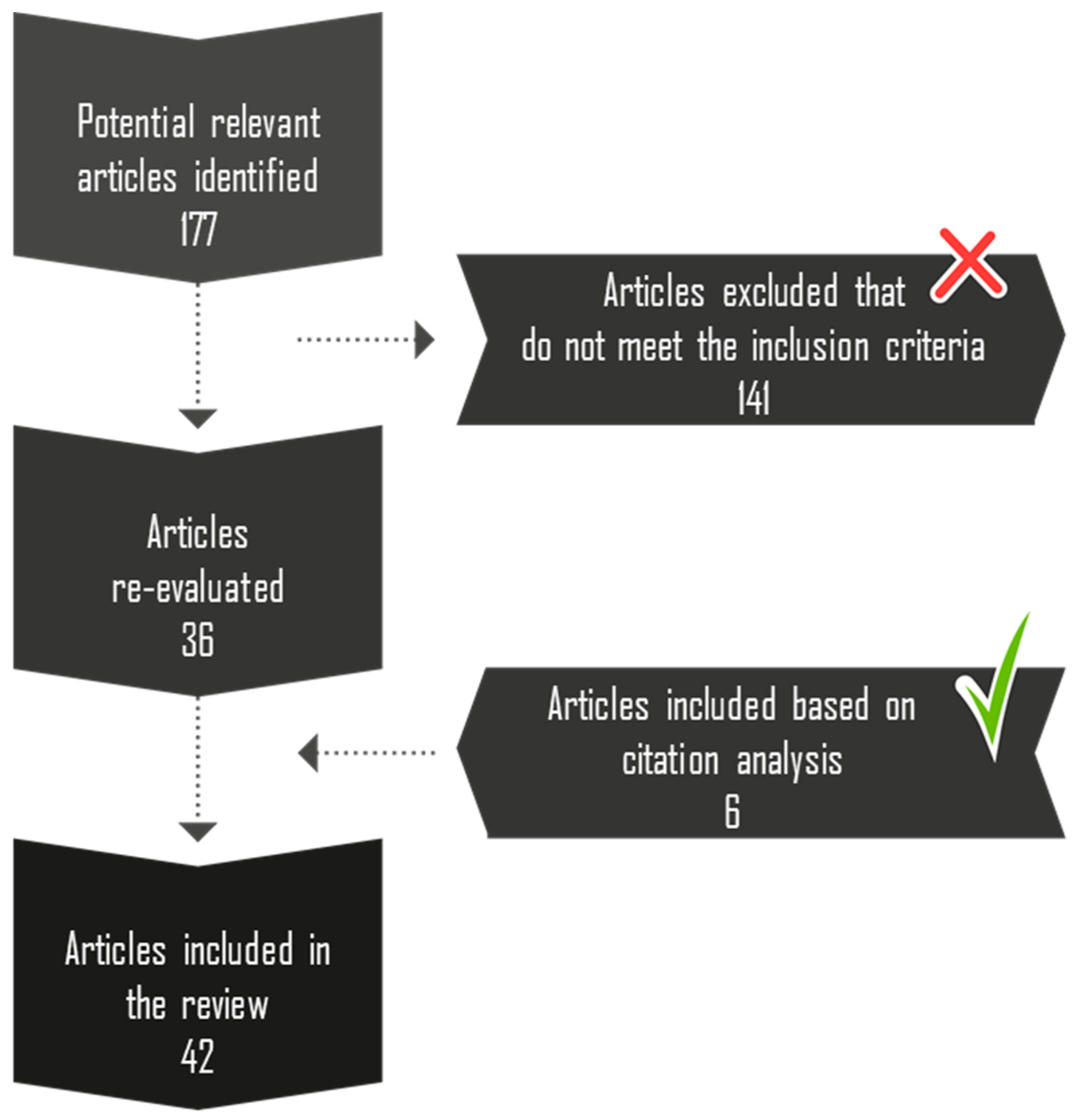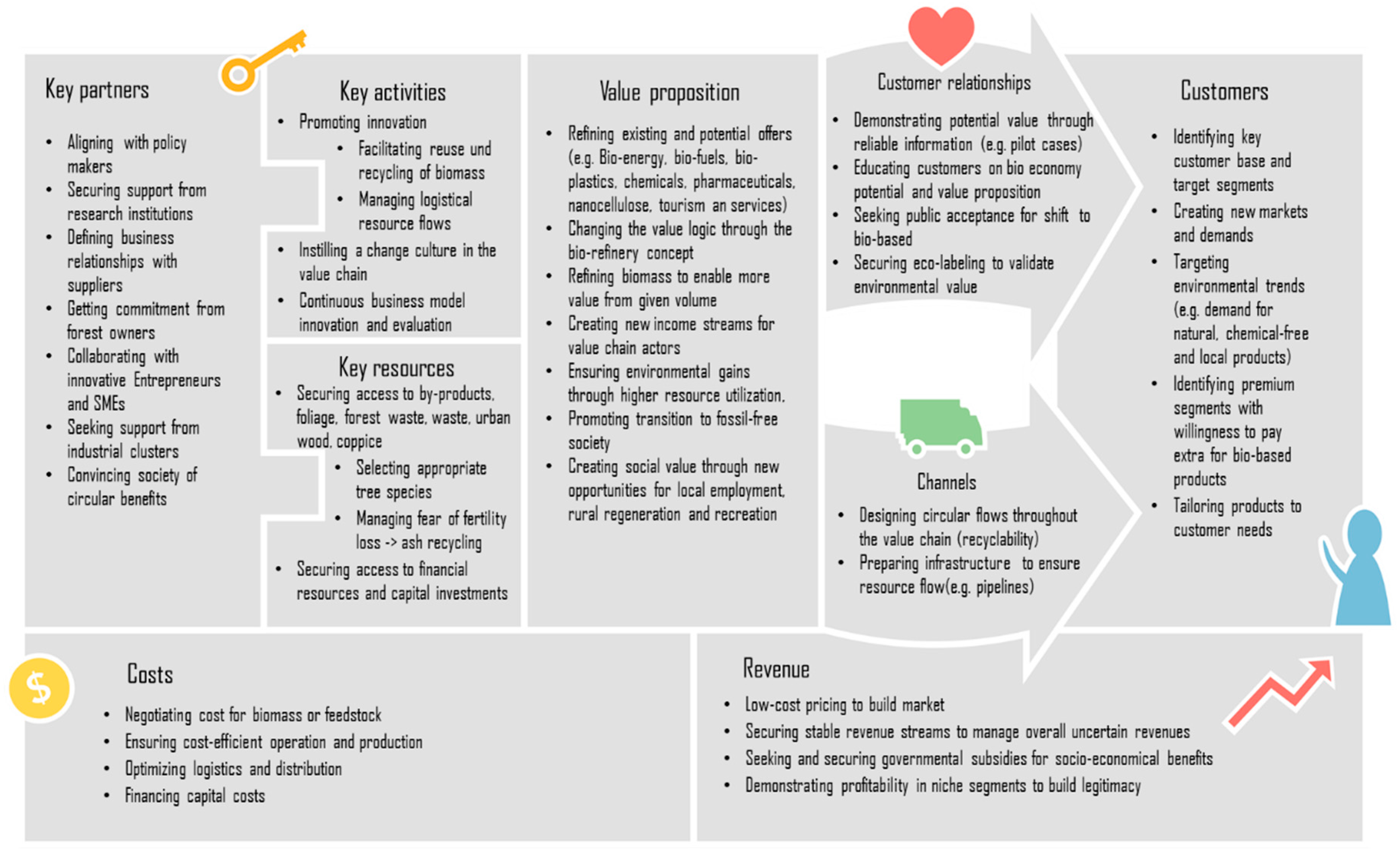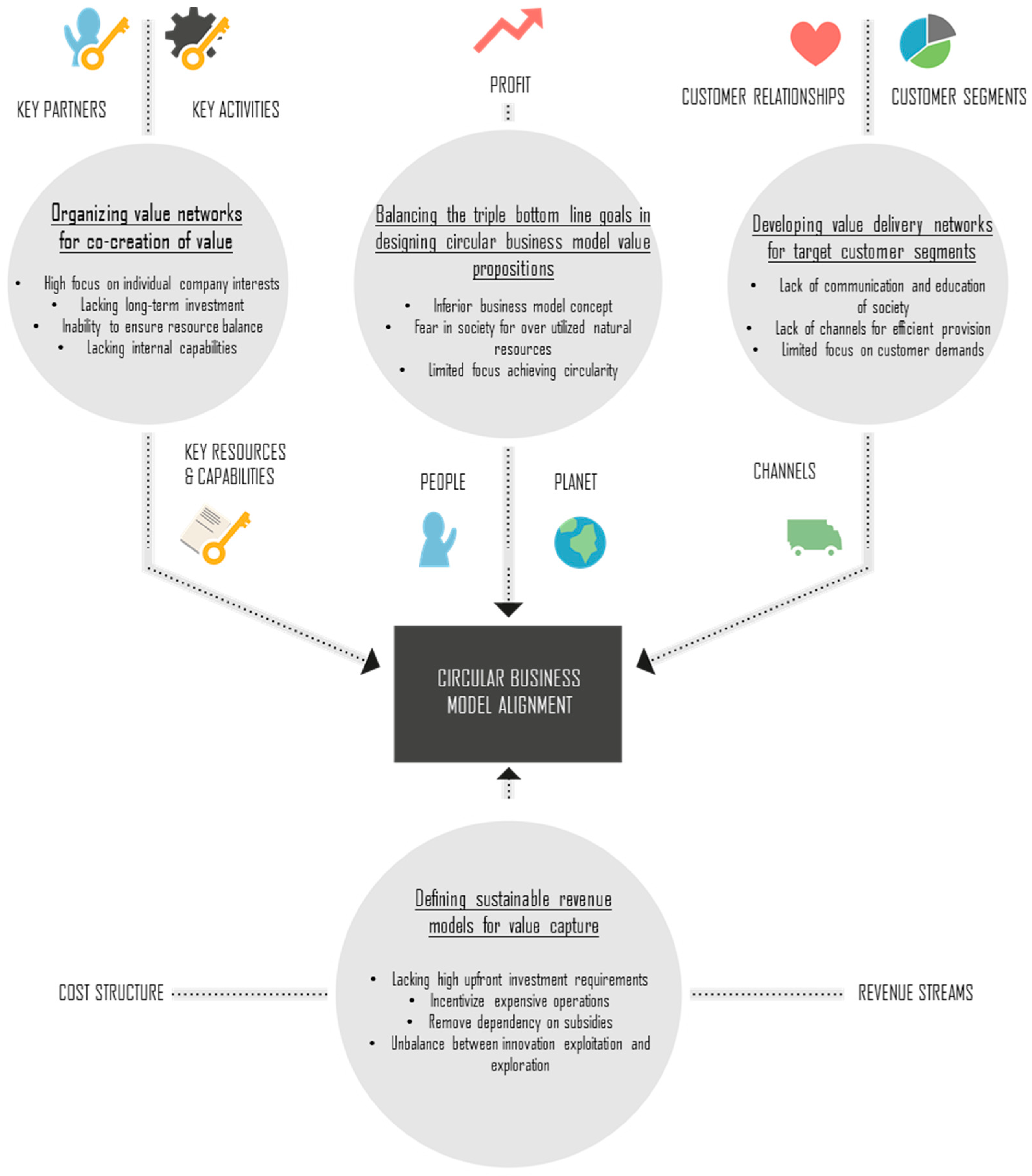Circular Business Models for the Bio-Economy: A Review and New Directions for Future Research
Abstract
1. Introduction
2. Research Method
3. Research Results
3.1. Value Proposition
3.2. Key Activities
3.3. Key Resources
3.4. Key Partners
3.5. Customer Relationship
3.6. Channels
3.7. Customer Segments
3.8. Cost Structure
3.9. Revenue Streams
4. Barriers to Circular Business Model Implementation in a Bio-Economy
4.1. Balancing the Triple Bottom Line Goals in Designing Circular Business Model Value Propositions
- How to integrate circularity principles for bio-based products into the design of circular business models?
- How to implement the circularity thinking into the design, development, and implementation phases of offer development?
- How to include interests of diverse stakeholders (including government and citizens) from society to be part of circular business models?
- How to develop offers that are commercially attractive without governmental support in order to successfully compete on their own merits with traditional or existing products?
4.2. Organizing Value Networks for Cocreation of Value
- How to orchestrate network actors into joining forces for value cocreation? What roles and responsibilities should network or ecosystem actors take for implementation of circular business models?
- How to integrate a resource balance into the design and development of the business model? How to evaluate which alternative uses of resources are most applicable to realize the goals of the bio-economy?
- Which organizational capabilities will be critical in incentivizing network actors to adopt circular business models? How can companies develop missing capabilities?
4.3. Developing Value Delivery Networks for Target Customer Segments
- How to identify appropriate customer segments for circular business models? What customer characteristics are unique for early acceptance of the goals of a bio-economy?
- How to utilize novel channels for efficient delivery? How can the channel involve new actors (e.g., SMEs) that specialize in higher competence in service delivery?
- How to increase the customers’ readiness to adopt a circular business model? What factors can enable behavioral changes in customers?
4.4. Defining Sustainable Revenue Models for Value Capture
- How to design multiactor revenue models for circular business models? How to scale such specialized revenue models from one region to another or from one country to another?
- How to incentivize private and public actors to support the early investment costs? How do they ensure that circular business models survive without favorable support structures?
- How to match value creation with value capturing activities within a traditional industry such as forestry to transform into a significantly different circular business model?
4.5. Barriers to Circular Business Model Alignment
- How can customer demands, which focus on designing an offer that the customer wants to buy, be aligned with the aim of utilizing the latest and most innovative bio-based technology for a market that does not exist yet? This dilemma shows a need for alignment between the customer’s readiness and acceptance of innovative technology. How can bio-economy industrial dynamics cope with this technological pull and push dilemma?
- How can high and specific customer requirements, which might be difficult for the provider firm to fulfil, such as that the provider takes a certain responsibility or fulfills specific standards (e.g., in terms of environmental impact), be aligned with the new capabilities requirement?
- How can individual and common interests of ecosystem actors be aligned to create a well-functioning business ecosystem to, for example, manage resource flows and competences? How can a company fairly divide the revenue among the ecosystem actors, when certain actors may lose their dominant ecosystem position? How does a company ensure that individual interests are overlooked to achieve the common good through a circular business model in a bio-economy?
- How can the focal actor’s interest in exploiting existing technologies be aligned with the need to invest in the exploration of new technologies even though this is related to higher levels of uncertainty, complexity, and ambiguity?
5. Conclusions
Author Contributions
Funding
Acknowledgments
Conflicts of Interest
References
- Kleinschmit, D.; Lindstad, B.H.; Thorsen, B.J.; Toppinen, A.; Roos, A.; Baardsen, S. Shades of green: A social scientific view on bioeconomy in the forest sector. Scand. J. For. Res. 2014, 29, 402–410. [Google Scholar] [CrossRef]
- Brodin, M.; Vallejos, M.; Opedal, M.T.; Area, M.C.; Chinga-Carrasco, G. Lignocellulosics as sustainable resources for production of bioplastics—A review. J. Clean. Prod. 2017, 162, 646–664. [Google Scholar] [CrossRef]
- Näyhä, A. Transition in the Finnish forest-based sector: Company perspectives on the bioeconomy, circular economy and sustainability. J. Clean. Prod. 2018, 209, 1294–1306. [Google Scholar] [CrossRef]
- Scarlat, N.; Dallemand, J.F.; Monforti-Ferrario, F.; Nita, V. The role of biomass and bioenergy in a future bioeconomy: Policies and facts. Environ. Dev. 2015, 15, 3–34. [Google Scholar] [CrossRef]
- Devappa, R.K.; Rakshit, S.K.; Dekker, R.F. Forest biorefinery: Potential of poplar phytochemicals as value-added co-products. Biotechnol. Adv. 2015, 33, 681–716. [Google Scholar] [CrossRef] [PubMed]
- McCormick, K.; Kautto, N. The bioeconomy in Europe: An overview. Sustainability 2013, 5, 2589–2608. [Google Scholar] [CrossRef]
- Chesbrough, H.; Rosenbloom, R.S. The role of the business model in capturing value from innovation: Evidence from Xerox Corporation’s technology spin-off companies. Ind. Corp. Chang. 2002, 11, 529–555. [Google Scholar] [CrossRef]
- Bocken, N.M.; Short, S.W.; Rana, P.; Evans, S. A literature and practice review to develop sustainable business model archetypes. J. Clean. Prod. 2014, 65, 42–56. [Google Scholar] [CrossRef]
- Nabuurs, G.J.; Schelhaas, M.J.; Hendriks, K.; Hengeveld, G.M. Can European forests meet the demands of the bio-economy in the future? Wood supply alongside environmental services. In Forests and Globalization: Challenges and Opportunities for Sustainable Development; Routledge: Abingdon, UK, 2014; pp. 153–165. [Google Scholar]
- Frishammar, J.; Parida, V. Circular business model transformation: A roadmap for incumbent firms. Calif. Manag. Rev. 2018, 61, 5–29. [Google Scholar] [CrossRef]
- Lewandowski, M. Designing the business models for circular economy—Towards the conceptual framework. Sustainability 2016, 8, 43. [Google Scholar] [CrossRef]
- Bocken, N.M.; Schuit, C.S.; Kraaijenhagen, C. Experimenting with a circular business model: Lessons from eight cases. Environ. Innov. Soc. Transit. 2018, 28, 79–95. [Google Scholar] [CrossRef]
- D’Amato, D.; Veijonaho, S.; Toppinen, A. Towards sustainability? Forest-based circular bioeconomy business models in Finnish SMEs. For. Policy Econ. 2018, in press. [Google Scholar]
- Ünal, E.; Urbinati, A.; Chiaroni, D. Managerial practices for designing circular economy business models: The case of an Italian SME in the office supply industry. J. Manuf. Technol. Manag. 2018, 30, 561–589. [Google Scholar] [CrossRef]
- Markman, G.D.; Siegel, D.S.; Wright, M. Research and technology commercialization. J. Manag. Stud. 2008, 45, 1401–1423. [Google Scholar] [CrossRef]
- Parida, V.; Sjödin, D.; Reim, W. Reviewing Literature on Digitalization, Business Model Innovation, and Sustainable Industry: Past Achievements and Future Promises. Sustainability 2019, 11, 391. [Google Scholar] [CrossRef]
- Ritter, T.; Lettl, C. The wider implications of business-model research. Long Range Plan. 2018, 51, 1–8. [Google Scholar] [CrossRef]
- Osterwalder, A.; Pigneur, Y. Business Model Generation: A Handbook for Visionaries, Game Changers, and Challengers; Wiley: Hoboken, NJ, USA, 2010. [Google Scholar]
- Cook, D.J.; Greengold, N.L.; Ellrodt, A.G.; Weingarten, S.R. The relation between systematic reviews and practice guideline. Ann. Intern. Med. 1997, 127, 201–216. [Google Scholar] [CrossRef]
- Reim, W.; Parida, V.; Örtqvist, D. Product–Service Systems (PSS) business models and tactics–a systematic literature review. J. Clean. Prod. 2015, 97, 61–75. [Google Scholar] [CrossRef]
- Kajanus, M.; Iire, A.; Eskelinen, T.; Heinonen, M.; Hansen, E. Business model design: New tools for business systems innovation. Scand. J. For. Res. 2014, 29, 603–614. [Google Scholar] [CrossRef]
- Cambero, C.; Sowlati, T. Assessment and optimization of forest biomass supply chains from economic, social and environmental perspectives—A review of literature. Renew. Sustain. Energy Rev. 2014, 36, 62–73. [Google Scholar] [CrossRef]
- Ersson, C.; Ammenberg, J.; Eklund, M. Biofuels for transportation in 2030: Feedstock and production plants in a Swedish county. Biofuels 2013, 4, 379–395. [Google Scholar] [CrossRef]
- Harfouche, A.; Khoury, S.; Fabbrini, F.; Mugnozza, G.S. Forest biotechnology advances to support global bioeconomy. Ann. Silvic. Res. 2015, 38, 42–50. [Google Scholar]
- Hansen, E. Responding to the bioeconomy: Business model innovation in the forest sector. In Environmental Impacts of Traditional and Innovative Forest-Based Bioproducts; Springer: Singapore, 2016; pp. 227–248. [Google Scholar]
- Iles, A.; Martin, A.N. Expanding bioplastics production: Sustainable business innovation in the chemical industry. J. Clean. Prod. 2013, 45, 38–49. [Google Scholar] [CrossRef]
- Machani, M.; Nourelfath, M.; D’Amours, S. A Multi-Level Decisional Approach to Design Integrated Forest Biorefinery Business Model for Pulp and Paper Companies; CIRRELT: Montreal, QC, Canada, 2014; Volume 7. [Google Scholar]
- Pelli, P.; Haapala, A.; Pykäläinen, J. Services in the forest-based bioeconomy—Analysis of European strategies. Scand. J. For. Res. 2017, 32, 559–567. [Google Scholar] [CrossRef]
- Gregg, J.S.; Bolwig, S.; Hansen, T.; Solér, O.; Ben Amer-Allam, S.; Pladevall Viladecans, J.; Fevolden, A. Value Chain Structures that Define European Cellulosic Ethanol Production. Sustainability 2017, 9, 118. [Google Scholar] [CrossRef]
- Jernström, E.; Karvonen, V.; Kässi, T.; Kraslawski, A.; Hallikas, J. The main factors affecting the entry of SMEs into bio-based industry. J. Clean. Prod. 2017, 141, 1–10. [Google Scholar] [CrossRef]
- Näyhä, A.; Pesonen, H.L. Diffusion of forest biorefineries in Scandinavia and North America. Technol. Forecast. Soc. Chang. 2012, 79, 1111–1120. [Google Scholar] [CrossRef]
- Roberts, D.; Nikolakis, W. Thoughts on transforming the forest sector. The potential (and reality) of the bio-economy. In Forests and Globalization: Challenges and Opportunities for Sustainable Development; Routledge: Abingdon, UK, 2014. [Google Scholar]
- Scoma, A.; Rebecchi, S.; Bertin, L.; Fava, F. High impact biowastes from South European agro-industries as feedstock for second-generation biorefineries. Crit. Rev. Biotechnol. 2016, 36, 175–189. [Google Scholar] [CrossRef]
- Lunnan, A.; Vilkriste, L.; Wilhelmsen, G.; Mizaraite, D.; Asikainen, A.; Röser, D. Policy and economic aspects of forest energy utilisation. Sustainable Use of Forest Biomass for Energy: A Synthesis with Focus on the Baltic and Nordic Region; Springer: Dordrecht, The Netherlands, 2008; pp. 197–234. [Google Scholar]
- Brand, D.; Singh, D. What is needed to make markets for ecosystem services a reality? In Forests and Globalization: Challenges and Opportunities for Sustainable Development; Routledge: Abingdon, UK, 2014. [Google Scholar]
- MacFarlane, D.W. Potential availability of urban wood biomass in Michigan: Implications for energy production, carbon sequestration and sustainable forest management in the USA. Biomass Bioenergy 2009, 33, 628–634. [Google Scholar] [CrossRef]
- Franklin-Johnson, E.; Figge, F.; Canning, L. Resource duration as a managerial indicator for Circular Economy performance. J. Clean. Prod. 2016, 133, 589–598. [Google Scholar] [CrossRef]
- Pan, S.Y.; Du, M.A.; Huang, I.T.; Liu, I.H.; Chang, E.E.; Chiang, P.C. Strategies on implementation of waste-to-energy (WTE) supply chain for circular economy system: A review. J. Clean. Prod. 2015, 108, 409–421. [Google Scholar] [CrossRef]
- Pergola, M.; Gialdini, A.; Celano, G.; Basile, M.; Caniani, D.; Cozzi, M.; Ventura, G. An environmental and economic analysis of the wood-pellet chain: Two case studies in Southern Italy. Int. J. Life Cycle Assess. 2017, 23, 1675–1684. [Google Scholar] [CrossRef]
- Spinelli, R.; Magagnotti, N.; Schweier, J. Trends and Perspectives in Coppice Harvesting. Croat. J. For. Eng. 2017, 38, 219–230. [Google Scholar]
- Spinelli, R.; Pari, L.; Aminti, G.; Magagnotti, N.; Giovannelli, A. Mortality, re-sprouting vigor and physiology of coppice stumps after mechanized cutting. Ann. For. Sci. 2017, 74, 5. [Google Scholar] [CrossRef]
- Bohlin, F.; Roos, A. Wood fuel supply as a function of forest owner preferences and management styles. Biomass Bioenergy 2002, 22, 237–249. [Google Scholar] [CrossRef]
- Mustalahti, I. The responsive bioeconomy: The need for inclusion of citizens and environmental capability in the forest based bioeconomy. J. Clean. Prod. 2017, 172, 3781–3790. [Google Scholar] [CrossRef]
- Lynch, D.H.; Klaassen, P.; Broerse, J.E. Unraveling Dutch citizens’ perceptions on the bio-based economy: The case of bioplastics, bio-jetfuels and small-scale bio-refineries. Ind. Crop. Prod. 2017, 106, 130–137. [Google Scholar] [CrossRef]
- Sjödin, D.R.; Parida, V.; Wincent, J. Value co-creation process of integrated product-services: Effect of role ambiguities and relational coping strategies. Ind. Mark. Manag. 2016, 56, 108–119. [Google Scholar] [CrossRef]
- Reim, W.; Sjödin, D.R.; Parida, V. Servitization of global service network actors—A contingency framework for matching challenges and strategies in service transition. J. Bus. Res. 2019, in press. [Google Scholar] [CrossRef]
- Reim, W.; Parida, V.; Sjödin, D.R. Risk management for product-service system operation. Int. J. Oper. Prod. Manag. 2016, 36, 665–686. [Google Scholar] [CrossRef]
- Reim, W.; Sjödin, D.; Parida, V. Mitigating adverse customer behaviour for product-service system provision: An agency theory perspective. Ind. Mark. Manag. 2018, 74, 150–161. [Google Scholar] [CrossRef]



© 2019 by the authors. Licensee MDPI, Basel, Switzerland. This article is an open access article distributed under the terms and conditions of the Creative Commons Attribution (CC BY) license (http://creativecommons.org/licenses/by/4.0/).
Share and Cite
Reim, W.; Parida, V.; Sjödin, D.R. Circular Business Models for the Bio-Economy: A Review and New Directions for Future Research. Sustainability 2019, 11, 2558. https://doi.org/10.3390/su11092558
Reim W, Parida V, Sjödin DR. Circular Business Models for the Bio-Economy: A Review and New Directions for Future Research. Sustainability. 2019; 11(9):2558. https://doi.org/10.3390/su11092558
Chicago/Turabian StyleReim, Wiebke, Vinit Parida, and David R. Sjödin. 2019. "Circular Business Models for the Bio-Economy: A Review and New Directions for Future Research" Sustainability 11, no. 9: 2558. https://doi.org/10.3390/su11092558
APA StyleReim, W., Parida, V., & Sjödin, D. R. (2019). Circular Business Models for the Bio-Economy: A Review and New Directions for Future Research. Sustainability, 11(9), 2558. https://doi.org/10.3390/su11092558





